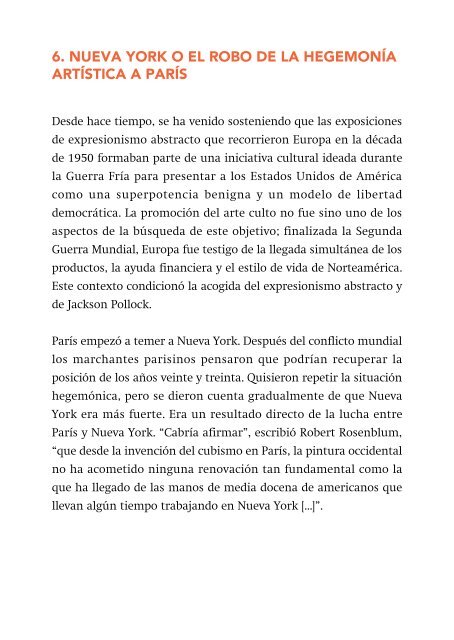MURAL JACKSON POLLOCK
cuadernillo_Jackson_Pollock
cuadernillo_Jackson_Pollock
Create successful ePaper yourself
Turn your PDF publications into a flip-book with our unique Google optimized e-Paper software.
6. NUEVA YORK O EL ROBO DE LA HEGEMONÍA<br />
ARTÍSTICA A PARÍS<br />
6. NEW YORK, OR THE SHIFT OF ARTISTIC<br />
HEGEMONY FROM PARIS<br />
Desde hace tiempo, se ha venido sosteniendo que las exposiciones<br />
de expresionismo abstracto que recorrieron Europa en la década<br />
de 1950 formaban parte de una iniciativa cultural ideada durante<br />
la Guerra Fría para presentar a los Estados Unidos de América<br />
como una superpotencia benigna y un modelo de libertad<br />
democrática. La promoción del arte culto no fue sino uno de los<br />
aspectos de la búsqueda de este objetivo; finalizada la Segunda<br />
Guerra Mundial, Europa fue testigo de la llegada simultánea de los<br />
productos, la ayuda financiera y el estilo de vida de Norteamérica.<br />
Este contexto condicionó la acogida del expresionismo abstracto y<br />
de Jackson Pollock.<br />
París empezó a temer a Nueva York. Después del conflicto mundial<br />
los marchantes parisinos pensaron que podrían recuperar la<br />
posición de los años veinte y treinta. Quisieron repetir la situación<br />
hegemónica, pero se dieron cuenta gradualmente de que Nueva<br />
York era más fuerte. Era un resultado directo de la lucha entre<br />
París y Nueva York. “Cabría afirmar”, escribió Robert Rosenblum,<br />
“que desde la invención del cubismo en París, la pintura occidental<br />
no ha acometido ninguna renovación tan fundamental como la<br />
que ha llegado de las manos de media docena de americanos que<br />
llevan algún tiempo trabajando en Nueva York [...]”.<br />
It has been argued for some time that the exhibitions of Abstract<br />
Expressionism which toured Europe in the 1950s formed part of a<br />
Cold War cultural initiative aimed at presenting the United States<br />
as a benign superpower and a model of democratic freedom.<br />
The promotion of high art was only one aspect of the pursuit of<br />
this goal, as Europe witnessed the simultaneous arrival after the<br />
Second World War of the products, financial aid and lifestyle of<br />
North America. This context conditioned the reception of Abstract<br />
Expressionism and Jackson Pollock.<br />
Paris started to fear New York. After the world conflict, Parisian<br />
dealers expected they would be able to return to the situation of<br />
the 1920s and 1930s. Though they hoped to recover the hegemony<br />
of those decades, the direct result of the struggle between New<br />
York and Paris was their gradual realisation that New York was the<br />
stronger of the two. “Not since the invention of Cubism in Paris,”<br />
wrote Robert Rosenblum, “has Western painting undergone such<br />
fundamental reorientations as it has in the hands of some halfdozen<br />
Americans working recently in New York [...].”


